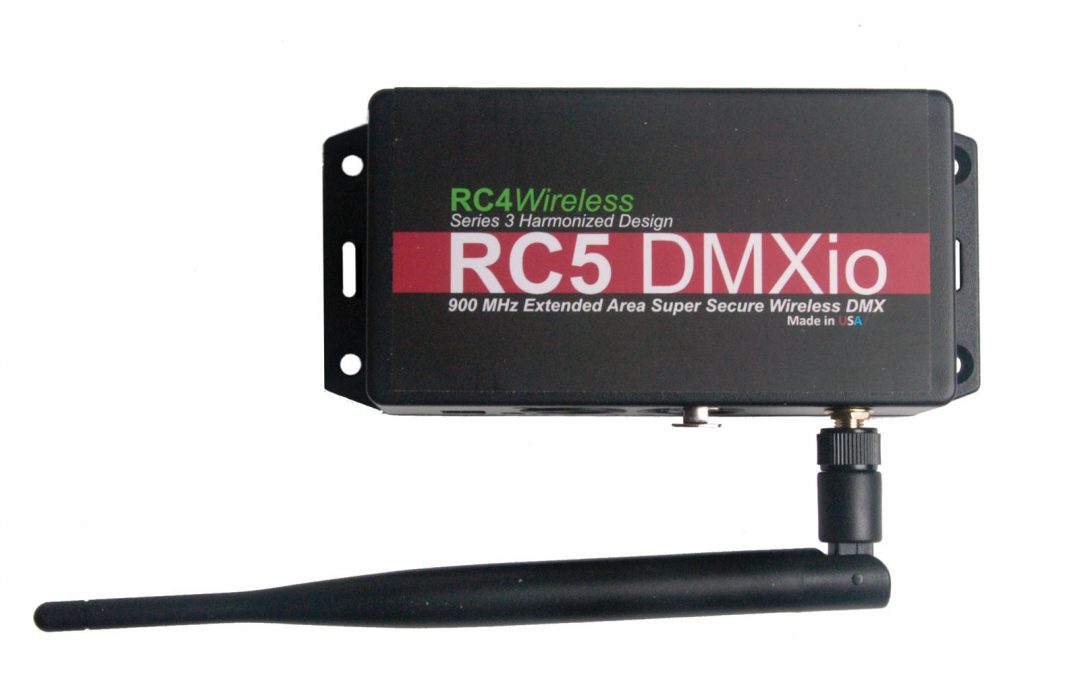RC4 Features
Reliable, feature-filled wireless DMX and dimming for lighting, props, costumes, and scenery.

Wireless DMX 512 simply replaces DMX 512 cables in a lighting system. Instead, the data from the controller goes into a DMX connector on a wireless transmitter, and the data moves wirelessly through the air. A receiver picks up that data and reproduces it on a DMX connector. For the user, it works just like a cable, but without the wire.
Good quality wireless DMX is carefully engineered to avoid delays in the process of transmitting and receiving, and not suffer dropouts that might be caused by other wireless technology in the vicinity. The top four wireless DMX systems do this so well that the reliability of the wireless connections surpasses the reliability of the wired connections for some metrics; the likelihood of channel jumping or ghosting is much lower for wireless than for wired, because the original DMX protocol from 1986 does not provide error detection or correction. All reputable wireless DMX systems use sophisticated methods to avoid and eliminate data errors.
Who can use wireless DMX?
Wireless DMX is ideal for individuals using wired DMX equipment who would like to get rid of cables, or avoid having to install them.
In theatre, it is used, along with wireless dimming, to get DMX data to mobile set pieces and small props. It can also be used to move data from the main DMX controller to fixtures up on a pipe, or in a dimmer rack, or anywhere else.
In motion picture production, wireless DMX is used to control lighting inside vehicles, on building rooftops, and much more.
Churches, museums and architectural restorations can use wireless DMX to easily add new lighting to existing facilities, without needing to break walls to run cables.
DJs can eliminate unsightly cables running along the floor and around doorways by using wireless DMX to control lighting trees, cop-lights, fog machines, and special effects.
In large arena and stadium productions, from music shows to cirque performances to sports half-time shows, wireless DMX is used to reduce setup times by eliminating the need to feed cables and then reel them back in. Wireless DMX can also be used in costumes and in specialty items like LED infused microphones and guitars.
How hard is it to use wireless DMX?
It’s not. Wireless DMX replaces cables, is quick and easy to use, and is reliable for significant distances.
Wireless DMX users need to be aware of other wireless systems in use, and if their system is interfering with other systems. They also need to think about DMX security, and take steps to make sure their system can’t be hacked. RC4’s System IDs eliminate that concern.
The venue itself is another concern. The technology needed in a stadium or arena is different that the ideal technology for a black-box theatre.
Do end users need any special skills to work with wireless DMX?
The best wireless DMX systems, regardless of the target market and the application, are plug-and-play. Some require one or two simple button presses to pair receivers with transmitters. Others work right out of the box with no need to touch anything at all.
Where can I learn more about working with wireless DMX?
The RC4 Knowledge Base has a wide variety of videos that highlight our products, and help users do things like run a servo motor, light a dollar store flicker candle, color match pixel strips and work with PWM frequencies.
